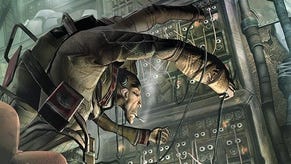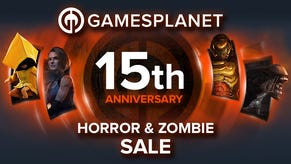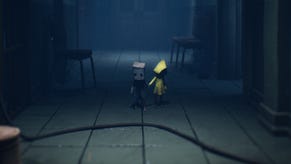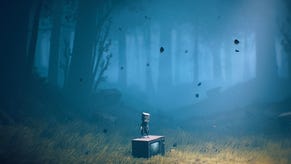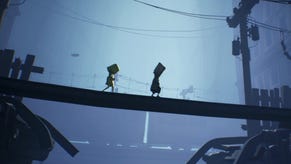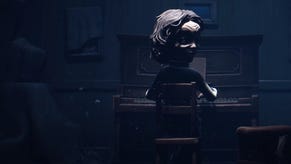An interview about what the hell's going on in Little Nightmares 2
"We have a whisk!"
This year's Gamescom didn't have much in terms of big news (aside from pissing in Death Stranding) - but one announcement that did sneak up on everyone was Little Nightmares 2: the sequel to Tarsier Studios' spooky platformer from 2017. Coming out next year, the game looks like it's bringing plenty of additions to the original formula, including a new character, different locations, two-character gameplay, and some form of "combat"... if that's what you can call the ladle fight going on in the announcement video.
Naturally, the trailer left fans asking plenty of questions, with many assuming the two-character gameplay meant co-op, and others wondering whether the ladle-slamming combat would form a core component of the game. I pitched these questions to lead producer Lucas Roussel and senior narrative designer Dave Mervik at Gamescom, who were able to answer some (but not all) fan queries, and also give some insight into the game design decisions behind Little Nightmares 2 and its new theme of "escapism".
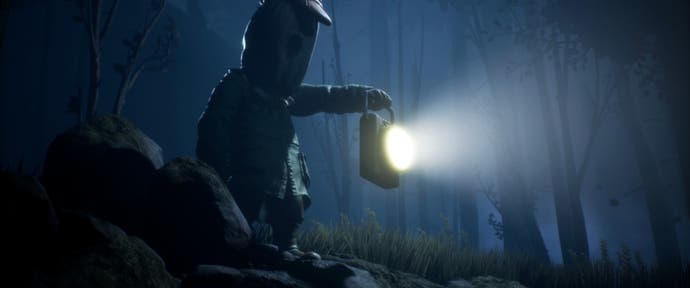
Is this a direct sequel to the first game, and when does it take place?
Mervik: It is a sequel to the first game, it's in the Little Nightmares timeline... is all I can say about that!
Does Six have her powers from the end of the first one?
Roussel: It's really something we don't want to disclose, because it would spoil the game if we answered that question.
Mervik: There's been a lot of people wondering about that, for sure. It's early days.
Roussel: Obviously having Six in this game means you'll definitely discover more about her personality, but the timeline also affects how Six will be in this game, so answering the question here could also answer the timeline question...

What can you tell us about the new locations - including the Signal Tower - and how that fits into the world outside The Maw?
Mervik: [The Signal Tower] is core to everything we're writing - but yeah, it's all outside compared to the first game. It was something we were really itching to do: we gave you glimpses in the first game of the guests heading to the banquet in The Maw, and things like that. We want to explore what this world outside looks like, that's been really nice for us. I think what you can know now is there's a forest area - a Little Nightmares forest though, so it's not got any Disney animals. And of course the Hunter is one of the unpleasant people you encounter. And the school as well is not like any school I was at.
Roussel: I think one of the things we found very interesting to do was... how do you make all those locations feel as claustrophobic as the indoor locations in the first game? Because like [Mervik] said, it's a very oppressive forest - even though you're adventuring outside, you feel like danger is lurking everywhere, so it was a challenge from a story and and design perspective to do that. But also you have many more environments and places, which we will reveal further down the line. And even inside each place - [Mervik] mentioned the school - there's a lot of variations within the school. So we're really excited to do something larger, bigger, with more variations.
Roussel: I'm really excited for people to find out more about [The Signal Tower] as well, because something about it sends out this pulse or transmission, and it affects everyone around it.
It definitely gave me 1984 vibes.
Mervik: That's good then!
Roussel: Everything is also linked to the televisions as well (that you see in the trailer) - they'll play a central role in the story but also a gameplay perspective, so that's going to be really fun.
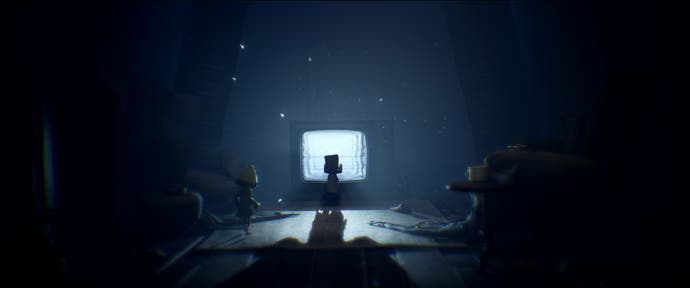
What sort of gameplay is involved with the televisions?
Mervik: You're asking loads of questions we can't tell you about!
Roussel: I think gameplay-wise, as we now have two characters it changes a lot of things. Even though you only play as one character's (Mono's) point of view. You were alone in the first game, you just had to take care of yourself, and that was really challenging. Now you've got two kids, so you'll have to take care of two kids. You know Six from the first game, you know her personality and how she is, and we want absolutely to be faithful to that in the second game as well. We know she's not passive from the first one, she's a strong character, so in some situations she'll definitely take the lead, in some situations you will have to help her out, and she will sometimes help you out. So I think gameplay-wise it's changing a lot, plus we're also adding more interactable items in the environment, and you can use them. That's another layer in the changes.
Could you tell us a bit more about the Hunter and the Teacher, and how they fit into the world, and their motivations?
Mervik: All of the residents of Little Nightmares... they don't really have motivations, it's like id - it's the base instinct of people, so we take this base instinct and pull it in different directions. So the Hunter is just bloodthirsty, he has the blood sport impulse I guess, just reduce people and animals to nothing or trophies on the wall, just pure naked aggression. They don't have a goal in life, that they want to achieve, it's just this urge - and I find that more nightmarish myself, when people don't have an agenda or evil plans for the day. Hopefully teachers won't be offended by this, but teachers can be terrifying - this sense of authority that people have over you as a child, teachers are wonderful as well - but this one isn't.

Once people saw there were two characters, people immediately said "oh it's co-op" and jumped to that conclusion: was co-op ever considered, and why did you go for an AI character instead?
Mervik: That was of course considered, because it would be the easy option, but it was also very quickly nixed because we know what we want to do with this game and the story and how we want people to feel, and co-op would just kill that. When you play Little Big Planet, you just mess around... and that would destroy the atmosphere we built up. While it would be nice for a while, it would demand everyone to play it the right way, and we'd be like 'stop ruining our game by doing it wrong'. So for us it was very clear that this had to be a single-player experience still - and we could then construct our AI in a way that was really faithful to the character of Six, and also play off those dynamics between the character of Mono and the Six that you know and maybe fear.
How would you describe the new character of Mono and what his personality's like?
Roussel: He likes to put items on his head. We can say that.
Mervik: That's a personality trait.
Roussel: So you can treat him as a shy boy, or someone who doesn't want to reveal his personality, but he usually covers his face when he can.
Mervik: He has a very cool coat.
Roussel: That's definitely something you will discover playing the game, but he's a very active character - he's protective, but you know how Six is, she doesn't need much protection, she's safe on her own. So it's really cool, we have a lot of things to explore, we have this new character that - of course, is central to this game. We have Six, who we know from the first game, and who we'll learn more about in the second game. And we have the relationship between the two, with highs, lows, cliffhangers. The story between the two kids is really central, the relationship evolves all the time, and that's something we're really excited about.

From watching the trailer, one of the new gameplay features appears to be combat - something not present in the first game. I was wondering if you could explain how that works, and how big a role it plays in the game?
Mervik: Yeah, I wouldn't call it combat, but I know what you mean.
Whacking people on the head with ladles?
Mervik: Yeah, clouting someone with a ladle. I mean, it's what a kid would do in that situation - they'd pick it up. It's something we wanted to do in the very beginning, but it didn't work in that first game, which was about being utterly alone and vulnerable - we've kind of turned that on its head, so we knew that didn't really fit here. It's a different kind of story. So this new boy comes in, and he wants to clout people over the head with a ladle. But it's still about defending yourself, it's not about going out and slashing everyone up with a lawnmower or whatever.
Roussel: When you face the Hunter with his shotgun you can pick up anything you want.
Mervik: We have a whisk!
Roussel: Obviously in some situations you will be able to pick up items and fight back, but you can't just pick up any weapons and go slash people.
So it's more a situational thing?
Roussel: You can also use it to progress in the levels with regards to puzzles - for example, you can use an item that will help you opening a door, so it's very contextual, and we also want to do - in some situations you will be able to pick up an item, maybe knock out small enemies, but if you want to sneak you can do that as well. You'll have the kind of situation where you have a choice to play the way you want.
Do you think having a weapon can take away the fear produced by not having anything to defend yourself with?
Mervik: I think it could feel that way, until you see how powerful you feel when you have your weapon and you realise it doesn't really make a difference - it's like hitting someone with a blade of grass. It might just tickle them enough for you to distract them or distract them and get away, so it's not like you're empowered now: if anything it reinforces how unempowered you are, you can try your best but then the Hunter's there with his big shotgun.
Roussel: But it opens a lot of options with the game design for you to use an item, maybe not necessarily to kill people with, but to do something in the level with.
Mervik: It's about being resourceful almost, going 'oh what can I do' - so we give you that extra freedom to maybe not just run or hide - you try your best, but this isn't a combat game.
Roussel: It fits well with the game, because we want to have like the first game so you can interact with pretty much everything in the levels, so I think it's just a nice continuation.
Is there a particular message you want to convey, or certain themes in this game, that may be different to the first one?
Mervik: Yeah, the theme in the first game is greed and consumption: it was originally called Hunger. The theme of this one is escapism - and we always pick a theme at the beginning... it's got to give people potential. They can say 'this inspires me' - it inspires the artists and the audio guys in certain ways, so with escapism there's so much going on there that you can play with, and pull in different directions.
So that feeds into the TVs?
Mervik: Exactly - but it's not just what it's going to be about, we'd like to explore the rich details in what this theme means, and how far can we take it. What does it mean for the world when it wants to escape something, and then what does that mean when you take that to Little Nightmares and amplify it in the way we do? Everything with Little Nightmares is taken from the world around us - we look around asking 'how do we feel about things now, how does that feed into the theme we want to explore, how does that manifest in these characters and these awful residents - how do we want to express ourselves through this world?' when we're discussing the theme. So it's those we want to talk about, and it's a really important theme to explore at the moment, I think. And hopefully we won't condemn ourselves as we're making games!



